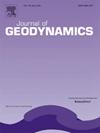Geodynamics of East Asia marginal sea basins: Stress field modelling
IF 2.1
3区 地球科学
Q2 GEOCHEMISTRY & GEOPHYSICS
引用次数: 0
Abstract
The East Asian marginal sea basins (EAMSB) are located at the junction between East Asia and the western Pacific plates, displaying a typical NE-trending en echelon pattern. Their formation is closely related to intense marginal extensional deformation since the Cenozoic. Owing to their intricate geological architecture and varied mechanisms of formation, these basins have emerged as a research hotspot in Earth science. However, due to limitations in geological observations and uncertainties in traditional tectonic models, the formation mechanisms of marginal sea basins remain highly controversial. This study integrates multi-source observational data and 3D spherical shell finite element method to systematically investigate the formation and evolution of the EAMSB, particularly focusing on their NE-trending en echelon pattern. The results indicate that the basin development in this region is primarily controlled by the far-field compressional stress generated by the India–Eurasia plate collision zone, as well as the extensional and radially downward shear stress imposed by the subduction of the Pacific and Philippine Sea plates. In addition, the episodic changes in regional tectonic stress play a key role in the formation of the EAMSB. The model delineates three principal evolutionary stages of the EAMSB: 1. In the early Eocene, the subduction of the Izanagi-Pacific ridge induced surface extension rather than compression along the eastern Asian margin due to shell bending. Meanwhile, under the combined influence of the India-Eurasia collision, rifting occurred along the East Asian margin. 2. In the late Eocene, the transition to subduction toward the Pacific Plate and the arrival of the Philippine Sea plate intensified boundary loads, triggering tectonic reversal and localised stress concentration. Simultaneously, as the India-Eurasia convergence zone entered the “hard collision” period, rifting was further facilitated. 3. From the Oligocene to early Miocene, the subducting plate became older and colder, with a steepening subduction angle, while the India–Eurasia collision continued. The rollback of the subducting plate induced eastward extension, which favored the development of eastward extensional deformation and led to the formation of a NE-trending en echelon pattern of the EAMSB.
东亚边缘海盆地球动力学:应力场模拟
东亚边缘海盆地位于东亚与西太平洋板块交界处,呈典型的ne向雁列型。它们的形成与新生代以来强烈的边缘伸展变形密切相关。由于其复杂的地质构造和多样的形成机制,这些盆地已成为地球科学研究的热点。然而,由于地质观测的局限性和传统构造模型的不确定性,边缘海盆地的形成机制仍然存在很大的争议。本研究结合多源观测资料和三维球壳有限元方法,系统研究了东东向雁梯队构造的形成与演化。结果表明,该地区的盆地发育主要受印度-欧亚板块碰撞带产生的远场挤压应力以及太平洋和菲律宾海板块俯冲作用产生的伸展和径向下切应力的控制。此外,区域构造应力的幕式变化对东洋大陆架的形成起着关键作用。该模型描述了EAMSB的三个主要进化阶段:始新世早期,伊扎那吉-太平洋洋脊的俯冲作用引起了东亚边缘的表面伸展,而不是由于壳的弯曲造成的表面压缩。同时,在印度-欧亚碰撞的共同影响下,东亚边缘发生了裂谷作用。2. 始新世晚期,太平洋板块向俯冲的转变和菲律宾海板块的到来加剧了边界载荷,引发构造反转和局部应力集中。同时,印度-欧亚辐合带进入“硬碰撞”期,进一步促进了裂谷作用。3. 渐新世至中新世早期,俯冲板块变老变冷,俯冲角度变陡,印度-欧亚碰撞继续。俯冲板块的回滚引起东拉,有利于东拉变形的发展,形成东东向雁梯队构造格局。
本文章由计算机程序翻译,如有差异,请以英文原文为准。
求助全文
约1分钟内获得全文
求助全文
来源期刊

Journal of Geodynamics
地学-地球化学与地球物理
CiteScore
4.60
自引率
0.00%
发文量
21
审稿时长
6-12 weeks
期刊介绍:
The Journal of Geodynamics is an international and interdisciplinary forum for the publication of results and discussions of solid earth research in geodetic, geophysical, geological and geochemical geodynamics, with special emphasis on the large scale processes involved.
 求助内容:
求助内容: 应助结果提醒方式:
应助结果提醒方式:


